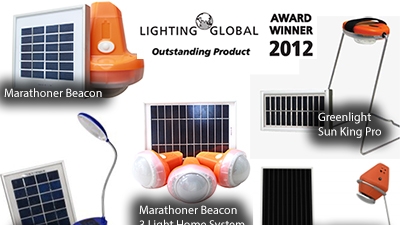Rewarding innovation is the key to providing consumers with more affordable choices in lighting solutions. “We must encourage development of quality, affordable lights because they are dramatically improving access to clean energy in low-income populations,” said Meike van Ginneken, the Bank’s Energy Sector Manager for West and Central Africa.
“We are beginning to see some government agencies embracing these products as part of their rural electrification strategies.”
Every off-grid lighting innovation counts, especially in Africa where about 600 million people and over 10 million micro-enterprises still do not have access to electricity. The competition attracted 25 entries under three categories:
1) BUDGET (less than US$30)
Winner: Marathoner Beacon MB2 090 (SooLED B1- Asia brand Name) - a competitively priced single-task light powerful enough to light a room. Highlight - “Super” setting provides 92 lumens for 5.1 hours after one day of solar charging.
Runner Up: Firefly 2.5 Mobile. Highlight - “High” setting provides 63 lumens for 3.6 hours after one day of solar charging. “Medium” setting provides 18 lumens for 13.8 hours after one day of solar charging.
2) MID-RANGE (between US$30-72)
Winner: Greenlight Planet Sun King™ Pro – this multipurpose lantern that can be used as a flash light/torch, a task light and a room light. Highlight - “Turbo” setting provides 110 lumens for 6 hours after one day of solar charging. “Normal” setting provides 44 lumens for 15 hours after one day of solar charging.
Runner Up: Sundial TSL01 – an ambient room light. Highlight - "High" setting provides 87 lumens for 4.1 hours after one day of solar charging. “Low” setting provides 34 lumens for 13 hours after one day of solar charging.
3) PREMIUM (between US$72-135)
Winner: Marathoner Beacon MB2 380/SooLED B3 – three lamp home lighting system. Highlight - the main lamp provides 210 lumens of light for 5.3 hours after a day of solar charging. The secondary lamps provide 92 lumens for 5.7 hours each after a day of solar charging.
Competing products were put through rigorous laboratory tests and were evaluated by rural customers in Senegal, Kenya, and India. The judges comprised a panel of experts from the UN Foundation, the German development agency GIZ, the Global Off-Grid Lighting Association (GOGLA), the Schatz Energy Research Center at Humboldt State University, and the World Bank Group’s Lighting Africa and Lighting Asia programs.
The conference, the third in six years, showed that Lighting Africa is on track to meet its targets of supporting the private sector supply 250 million in Africa with better lighting products by 2030.
More than 300 off-grid lighting stakeholders and over 40 exhibitors met to showcase the latest off-grid lighting technologies and business models to increase access to clean lighting for rural, low income populations.
Expanding Access with Off-Grid Lighting
In terms of sales, the market for off-grid lighting products in Africa grew by 300% from 2008 to 2012. An IFC publication, From Gap to Opportunity; Business Models for Scaling up Energy Access, shows that the global energy-for-the-poor market is a $37 billion opportunity, making the market attractive for those with innovative off-grid solutions. Key Trends and Developments in the Africa Off-Grid Lighting Market, shows a robust appetite for quality solar lanterns with sales doubling annually over the past three years.
In tune with the opportunity, this year’s conference was dominated by commercial players with high quality products. Discussions focused on what the industry could do to expand product distribution, marketing and business development initiatives in order to scale up operations, and further increase access to clean energy in Africa.
To sustain this growth, Lighting Africa will develop working capital and trade finance facilities across the supply chain and deepen its focus on building consumer trust in modern, quality assured lighting products through consumer education. The World Bank will accelerate its work with client countries to build Lighting Africa activities into energy access programs that it finances, helping spur consumer demand and supply chains to the base of the pyramid.
Jérôme Crétégny, Senior Country Officer responsible for IFC operations in Senegal, Cape Verde, Gambia, Guinea Bissau, Mali and Mauritania said: “These awards showcase manufacturers’ versatility and responsiveness to the challenge of bringing to market high quality yet affordable products that meet the energy needs of people without electricity. This convinces us that everyone can enjoy clean energy by 2030.”


